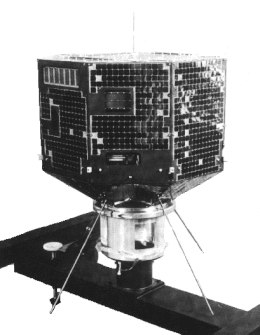Hakucho
Hakucho (also known as CORSA-b before launch; CORSA stands for Cosmic Radiation Satellite) was Japan's first X-ray astronomy satellite, developed by the Institute of Space and Aeronautical Science (then a division of the University of Tokyo). It was launched by the ISAS M-3C rocket on the M-3C-4 mission on February 21, 1979 and reentered the atmosphere on April 15, 1985.[1]
 | |
| Mission type | X Ray Celestial Observation |
|---|---|
| Operator | Institute of Space and Astronautical Science (Japan) |
| COSPAR ID | 1979-014A |
| SATCAT no. | 11272 |
| Spacecraft properties | |
| Launch mass | 96.0 kilograms (211.6 lb) |
| Dimensions | ⌀760mm×650mm |
| Start of mission | |
| Launch date | 21 February 1979 UTC |
| Rocket | M-3C-Rocket (mission 4) |
| Launch site | Uchinoura Space Center, Kagoshima Prefecture, Japan |
| End of mission | |
| Decay date | April 15, 1985 |
It was a replacement for the CORSA satellite which failed to launch due to rocket failure on February 4, 1976.[2]
Highlights
- Discovery of soft X-ray transient Cen X-4 and Aql X-1
- Discovery of many burst sources
- Long-term monitoring of X-ray pulsar (e.g. Vela X-1)
- Discovery of 2 Hz variability in the Rapid Burster later named Quasi Period Oscillation.
gollark: Never mind, zstd gets similar ratios, seems plausible.
gollark: It compresses those 5MB to 16.5KB? Implausible.
gollark: https://drive.google.com/drive/folders/1OL0D5ujUX3Eyd3xcSbeXaEWe0nRmT5U1
gollark: You should compress my 500MB gollarious neural network.
gollark: Iterate through all possible programs and store the shortest one which produces the output.
References
This article is issued from Wikipedia. The text is licensed under Creative Commons - Attribution - Sharealike. Additional terms may apply for the media files.